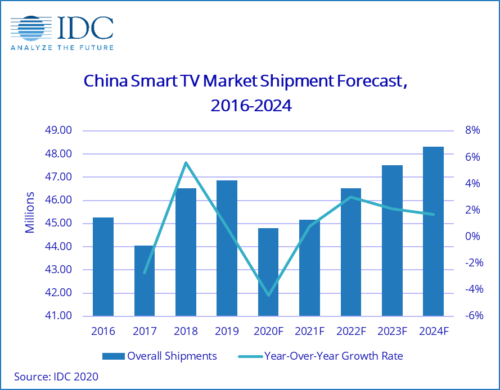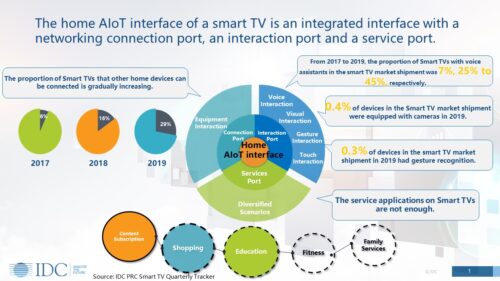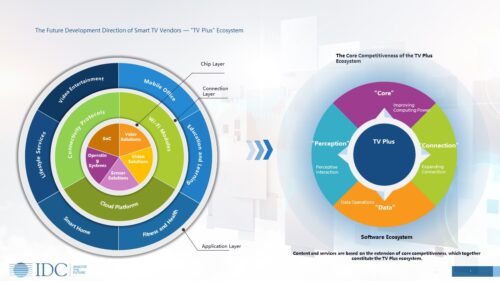44.8 million Smart TVs to be shipped to China in 2020
Thursday, August 27th, 2020
New IDC Smart TV Tracker Reveals 44.8M Units of Smart TVs Will be Shipped to China in 2020
BEIJING — The inaugural IDC China Quarterly Smart TV Tracker estimates 44.8 million units of smart TVs will be shipped to China in 2020 – a 4.4% decrease compared to last year. IDC believes improvement in connection and interaction intelligence in newer smart TV models will lead to increased consumption of smart TVs in China.

Currently, Smart TVs in China fall under the connection and interaction intelligence stage, and even then they are still far from being fully connected and intelligent. This is only stage two of what IDC believes to be a four-stage development journey for smart TVs: content intelligence, connection and interaction intelligence, scenario-based connection and interaction, and service-based connection and interaction.
“With 95% penetration of China’s smart TV market shipments, IDC sees an opportunity for smart TV’s to get to the next stage of Smart TV development and increase its market share,” says Sophie Pan, Research Manager for Client Systems Research at IDC China.
As most manufacturers continue to focus on video entertainment capabilities instead of expanding diversified scenarios, the evolution of smart TVs in China has yet to take off. In fact, only 29% of smart TVs on the market can connect with other home devices as of 2019 – 45% of which can support voice assistants.
With the help of Artificial Intelligence (AI) technology and home IoT device ecosystem, the voice interaction and connectivity afforded by smart TVs can allow it to be better integrated into a consumer’s work, live and play scenarios at home. The home AIoT interface of a smart TV is an integrated interface with a networking connection port, an interaction port, and a service port.
The future direction of smart TVs can be summarized as the “TV Plus” ecosystem which has five aspects ― core, connection, perception, data and software ecosystem ― that will lead to five trends:
- Core – Computing capabilities of the chip will be enhanced greatly and become the core driving force.
- Connection – Smart TV will be having a wider connection with the home and mobile devices, which would built on not only the applications, but also the operating system. Device interconnection will gradually develop from application layer connection to system layer connection.
- Perception – Home interaction interface develops from the centralized to the distributed, and the interaction will be more user-friendly with the support of various AI methods including voice, image, facial, touch, etc.
- Data – The data operations on the platform will become the “core asset” of the smart TV as the home AIoT interface.
- Software Ecosystem – will continuously power the development of smart TVs in the AIoT field.
“The computing capabilities of the chip, device connection, perceptive interaction, and data operations which depends on the chip layer and connectivity layer, are the core competitiveness of vendors. It will then become important for smart TV manufacturers in the future cooperation process. Furthermore, these features are vital selling points for attracting more third-party developers to build diversified application services,” Pan ends.
The IDC China Quarterly Smart TV Tracker is a quarter-based data tracker product, which provides the smart TV market size and competition landscape among the major vendors, such as Xiaomi, Hisense, TCL, Skyworth, Changhong, etc. It also shows the market trend in terms of the display features (screen size, resolution, ratio), and reveals the multiple interaction methods and connected platform.
Latest News
- Barb to start reporting TV-set viewing of YouTube channels
- SAT FILM selects multi-DRM from CryptoGuard
- Qvest and ARABSAT to launch OTT streaming platform
- ArabyAds & LG Ad Solutions partner with TVekstra in Turkey
- Freeview NZ satellite TV service to move to Koreasat 6
- Comscore expands YouTube CTV measurement internationally


